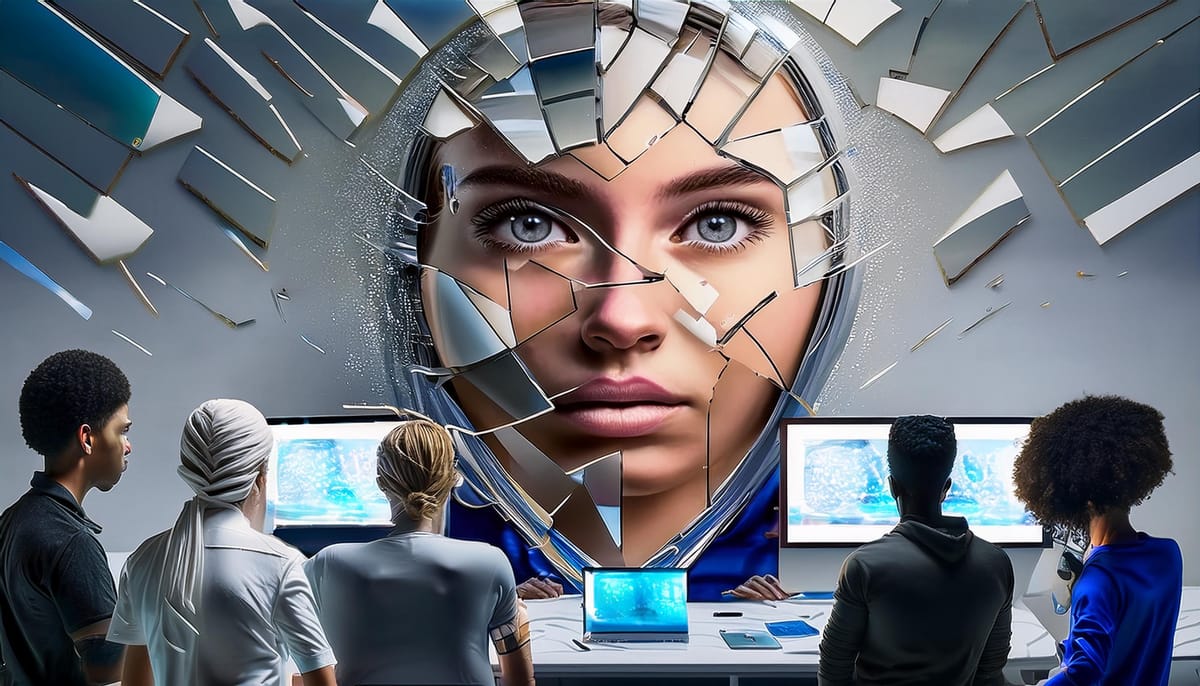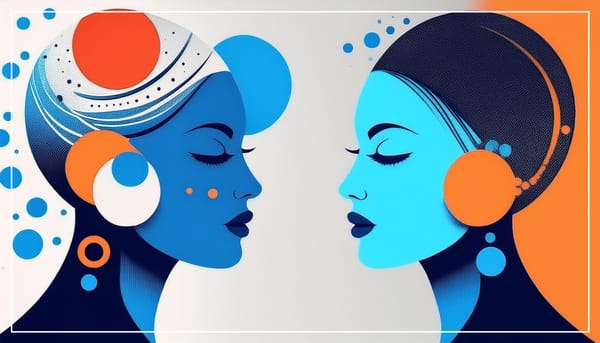Breaking Through Technology's Narcissus Trap

In my previous article, I introduced the concept of the Narcissus Trap in technology development - a phenomenon where tech professionals inadvertently create products that reflect their own experiences and biases, often neglecting the needs of diverse user groups.
Today, I want to share a story about what happened to me during a job interview. This story shows how the Narcissus Trap is a real issue in the tech world. It also helps explain why we need to change how we make tech products.
By examining this experience, we can see why it's so important to be thoughtful and understanding when creating technology. Our goal should be to make products that work well for everyone, not just a select few.
A Day of Vulnerability: The Personal Mirror
A few years ago, I found myself in an interview with a large tech company. It was my first interview in five years, and I approached it with equal parts curiosity and trepidation. I was a new mother to a three-month-old, grappling with sleep deprivation and a body that felt foreign to me. My interview outfit felt restrictive, and I had to coordinate multiple pumping breaks throughout the day.
But, there I was, as always, bringing my whole self to the situation. Sitting in a fishbowl room, surrounded by glass, with a conspicuous bag containing a giant pump beside me, I awaited an endless stream of interviewers. I felt exposed and vulnerable.
I was vulnerable. Interviews are hard. Interviews when you are uncomfortable in your own body, feel embarrassed by the need for special accommodation, and feel yourself growing uncomfortable as time passes are even harder.
Breaking Down the Interview Experience
The second-to-last interview was with a man representing the demographic building most software products. He asked me a product development question: “If you were responsible for developing and building features for a self-driving ride-hailing service, what unique feature sets would you build, and how would you market those features?” He opened up his laptop to document my answer and his impressions.
I had already thought about this a lot. I used ride-hailing services regularly, especially late at night. So I answered: I would develop features that center on safety, particularly for women and other vulnerable populations. For instance: keyless/personalized entry linked to the user’s device, options to specify single occupancy, and various ways to enhance “phone a friend” and ride-sharing location features.
My marketing campaign would center around "Get Home Safe." That would be the campaign's central message.
His response floored me. Leaning back in his chair, arms clasped behind his head in an unconscious display of dominance, he smirked and said, "For women and other vulnerable populations? That seems like a really niche user group."
I was stunned. Since when did 51% of the population become "niche" (not to mention the “other vulnerable populations” I mentioned)?
In that moment, I felt erased. It wasn't his negative feedback about my product ideas that bothered me – it was the implication that I, and others like me, weren't even worth considering as users. It’s not a new experience for me or anyone else who would categorize themselves in the same way, and it is often worse for members of the global majority.
That moment crystallized for me the deep-seated issues in our approach to product development.
Turning Away from the Mirror: Naming the Other
I don't think that this interviewer's response was particularly unique. In my experience, many product managers and designers find that sometimes merely naming a group of people by their identity, focusing on it at all, can feel like a move to exclude all others. We are a culture centered on a default (white, male, middle class), and recentering on anything else, particularly in product development, translates to making an exclusive product that excludes the default.
To be clear: I am not a sociologist. I would imagine that this phenomenon has likely been studied (and if someone can point me in the right direction, I'd love to do a deeper research dive). As it's not my area of expertise I am very rapidly out of my depth here – but it feels like something that is common in social movements as well.
While I can't speak to the broader sociological implications, I can share how I have seen how this plays out on tech teams. As a product manager, you want to build the product and features that are liked and used by the broadest customer base. Naming a specific audience group, or defining aspects of a feature that should be taken into consideration to accommodate a broader group can be misinterpreted as a move to exclude all others.
Shifting focus away from the accepted default is often misunderstood as making something exclusionary, rather than inclusionary. The truth is though, that not only is the global majority just that – a majority – but designing for inclusivity automatically creates better products. I would go so far as to say that even the default white male middle-class rideshare user would appreciate my safety features.
Analyzing the Narcissus Trap in Action
The interviewer's response, "For women and other vulnerable populations? That seems like a really niche user group," is a textbook example of the Narcissus Trap at work in the tech industry. This response highlights several critical issues:
First, it may indicate a narrow perspective. The interviewer, who represents the typical demographic in tech (white, male, able-bodied), overlooks that women make up roughly 50% of the global population and 51% of the US population. This oversight could stem from centering one’s own experiences.
Second, the response suggests a lack of empathy. By characterizing safety features for women and vulnerable populations as "niche," the interviewer struggled to empathize with experiences that differ from his own – a hallmark of the Narcissus Trap in technology.
Third, the reaction points to a failure to consider diverse user needs. Labeling the needs of women and other vulnerable groups as "niche," demonstrates a tendency to create products for users similar to the creators
Moreover, this mindset leads to missed market opportunities, overlooking a significant portion of potential users, valuable market segments and business opportunities.
Additionally, the response may reinforce exclusion. The dismissive attitude towards features designed for women and vulnerable populations perpetuates a cycle of creating technology that excludes or underserved certain groups. T
Finally, the interviewer's reaction underscores the bias present in product development, which leads to the creation of technologies that do not address the needs of a diverse user base. This bias is a core element of the Narcissus Trap in Technology and highlights the importance of inclusive design practices.
Strategies for Escaping the Narcissus Trap
Creating inclusive products doesn't require reinventing the wheel. Instead, it's about integrating user-focused practices into our existing development process. Here are key strategies to consider:
- Diverse Teams and Stakeholders: Build teams that reflect the diversity of your user base. This means considering not just demographic diversity, but also diversity in experiences, abilities, and perspectives. Consider using tools to create inclusive job descriptions and actively posting jobs in spaces that cater to diverse populations (e.g. LGBTQIA+ professional groups, ability job boards, etc).
- Comprehensive Audience Definition: At the start of each project, clearly define the target audience and their needs. Use a combination of data-driven approaches and design thinking methodologies and conduct empathy interviews with a diverse range of potential users. It can be helpful to use tools like MAXQDA to help analyze qualitative data. Avoid relying on made-up personas, which can reinforce existing biases.
- PESTLE Analysis: Conduct a modified PESTLE (Political, Economic, Social, Technological, Legal, and Environmental factors) analysis at the world, local, and institutional levels. This helps understand the broader context in which your product will exist and identifies potential areas of disenfranchisement for your audience.
- Write Specific User Stories: Write user stories that explicitly consider diverse user needs. Use a template like: "As a [specific user type], I want to [action] so that [benefit], considering [specific constraint or need]." For example: "As a user with low vision, I want to easily adjust text size so that I can comfortably read content, considering the need for responsive design across devices."
- Accessibility-First Development: Prioritize accessibility by adhering to WCAG standards. Use tools like axe DevTools for automated testing and implement ARIA attributes in your HTML to enhance screen reader compatibility.
- Inclusive Design Systems: Create a design system that prioritizes inclusivity. This should include color palettes tested for color blindness, typography choices that consider readability (aim for a minimum contrast ratio of 4.5:1 for normal text), and component designs that work across different device sizes and input methods.
- Localization and Internationalization: Plan for localization from the start. Use i18n libraries appropriate for your tech stack to separate text content from code. Consider cultural differences in design elements, date formats, and number systems
- Performance Optimization for Low-End Devices: Implement performance budgets and regularly test on low-end devices. Use tools like Lighthouse to measure and optimize load times, interactivity, and visual stability. Consider implementing techniques like lazy loading and code splitting to improve performance on slower connections.
- Continuous Inclusive Testing: Integrate inclusive testing into your CI/CD pipeline. Use automated tools for accessibility testing and Browserstack for cross-device testing. Regularly conduct usability testing with diverse user groups, including users with disabilities and those using assistive technologies.
- Advocacy and Education: Foster a culture of inclusivity within your organization by advocating for these practices and educating team members about the importance and benefits of inclusive design.
By implementing these strategies, we can create a more holistic approach to product development that truly serves all users. While even the smallest bit of awareness helps to increase inclusiveness in design, it requires constant effort and focus to maintain this perspective throughout the development process.
These strategies start to build a framework to avoid the pitfalls of the Narcissus Trap and create superior user experiences for a diverse range of users.
Some Examples of Inclusive Products
One company I love in this space is GIPHY. (Yes that GIPHY – the one that provides GIFs, the file type that is notoriously inaccessible.) First, GIPHY has made a full-throated commitment to Diversity and Inclusion in their business practices. You have to love an organization that puts its commitment out for the world to see and speaks plainly while doing so.
Second, recognizing that they are one of the largest and most popular repositories for GIFs, in recent years GIPHY teamed up with the content accessibility provider Scribely. Rather than using auto-generated alt text which is often fraught and wrong, Scribely employs expert writers to create content descriptions. What I also love is that GIPHY isn’t gatekeeping this innovation. Not only is it available through their platforms, but these fully accessible descriptions are available through their APIs so that all integrators can take advantage of them. Read more about the GIPHY-Scriplely matchup.
Finding inclusive design in the accessibility sector tends to be easier than finding really incredible products for other marginalized communities. This is due, in no small part, to accessibility as a compliance issue.
Finding inclusive design tech products aimed at the global majority is somewhat harder to do. There are some products that look interesting to me:
- Google’s Android One, was created to provide affordable smartphones in emerging markets.
- M-Pesa is a banking app that originated in Kenya. It allows users to keep their banking accounts on their phones.
- Another one that looks super interesting to me, aimed at Indigenous communities, is the Earth Defenders Toolkit.
Given that I don’t know enough about these products or any missteps that they may have had, I’ll have to do more targeted research on them before I expand on them here.
Lastly, there have been strides made for other vulnerable populations. Again, I have not directly used these, but read some articles on them so please correct me where I am misunderstanding. To my knowledge, a number of years ago, Tinder added tools to help the LGBTQIA+ community in hostile nations. I’ve also heard of GeoSure, which helps identify risks to vulnerable populations who are traveling to specific locations.
If you do research for technology for women, you’ll land on fertility and menstruation trackers. No surprise there. But in this current political climate I am not going to endorse or mention any that I think may be useful, as I am not confident in the data handling or privacy of any.
Let me know if you have experience with any of these, or can identify others that do a good job of inclusive design.
The Business Case: Beyond Self-Reflection
Don't get me wrong. This isn't just good for the underserved. It's also a smart business strategy that leads to better products and increased market share in the for-profit world.
- Expanded market reach: By designing for a diverse user base, you're automatically increasing your potential customer pool. Remember, the "niche" groups we often overlook may often actually represent the needs of the majority.
- Increased customer loyalty: When users feel seen and valued by a product, they're more likely to become loyal customers and brand advocates.
- Innovation driver: Inclusive design often leads to innovative solutions that benefit all users, not just the initially targeted group. Think of curb cuts - designed for wheelchair users, but beneficial for parents with strollers, travelers with luggage, and many others.
- Risk mitigation: Inclusive design can help avoid costly retrofits or PR nightmares that come from excluding or offending user groups.
- Regulatory compliance: As accessibility regulations become stricter globally, inclusive design ensures you're ahead of the curve.
One of many such studies, a 2018 study by Accenture found that companies that embraced disability inclusion were, on average, twice as likely to have higher total shareholder returns than those that didn't. That's not just doing good - it's good business.
The Future of Tech: Designing for All
Inclusive design is becoming increasingly essential in creating digital and physical environments that cater to a diverse range of users. Again, the focus has been mostly on accessibility. We need to have the focus include other vulnerable populations. Here are some of the emerging trends in inclusive design:
- Universal Accessibility: Universal accessibility is a growing trend that involves designing spaces and digital experiences to be accessible to everyone, regardless of their abilities. This concept extends beyond compliance with accessibility standards to create environments that are functional and aesthetically pleasing for all users.
- Designing for Neurodiversity: There is a shift towards designing spaces and digital products that accommodate neurodiverse individuals, such as those with autism, dyslexia, or attention-deficit disorders. This trend involves the use of technology, such as voice command monitors, to assist individuals in organizing their tasks.
- Inclusive Web Design: Inclusive web design emphasizes creating digital experiences that are accessible and usable for a broad audience. This involves using universal design principles to remove barriers and ensure that websites are navigable and understandable for all users. It includes considerations for people with mobility, vision, hearing, or sensory impairments, as well as the elderly and those with temporary disabilities.
- Enhanced Gesture and Motion Controls: Gesture and motion controls are increasingly used in virtual reality (VR) and augmented reality (AR) applications to provide alternative interaction methods for individuals with physical disabilities. These technologies offer new ways to navigate and interact with digital content, making it more accessible to a broader range of users.
- Mindful of Mental Health: Designing environments that prioritize mental well-being is becoming more important, especially as people return to physical workspaces. This trend involves creating a variety of working areas to accommodate different work modes and incorporating elements of home to create a welcoming and calming atmosphere.
As trends in inclusive design continue to evolve and gain traction, I believe we're on the cusp of a significant shift in the tech industry. Imagine a world where universal accessibility is no longer an afterthought, but a fundamental principle of product development.
We might see a new generation of tech leaders emerging from diverse backgrounds, bringing fresh perspectives and innovative solutions to long-standing problems. The line between assistive technology and mainstream products could blur, leading to more intuitive and adaptable interfaces for everyone.
Mental health considerations could reshape our work environments and digital spaces, potentially transforming productivity and well-being across the board.
In essence, by designing for all, we're not just making tech more inclusive – we're potentially redefining the very nature of innovation and user experience in our industry. It's an exciting prospect, and one that I believe will lead to better products, happier users, and a more equitable tech ecosystem for all.
Conclusion: From Reflection to Action
I think about that interview experience a lot. There is so much more to unpack about it, and I am sure it will come up again.
It was such a poignant moment for me, revealing how deeply entrenched the Narcissus Trap is in our industry. It's a reminder that creating truly inclusive technology requires more than good intentions—it demands deliberate action and systemic change.
As tech professionals and companies, we have a responsibility to:
- Actively seek out and amplify diverse perspectives, especially those different from our own
- Integrate inclusive design practices into every stage of development, from ideation to launch and beyond
- Regularly challenge our assumptions and biases, treating them as opportunities for growth rather than threats
- Advocate tirelessly for inclusivity within our organizations and the broader tech community
- Celebrate and learn from examples of inclusive design, using them as blueprints for our own work
By taking these steps, we can revolutionize our approach to technology development. We have the power to create products that not only avoid exclusion but actively embrace and empower the full spectrum of our global user base.
As you leave this article, reflect on your own experiences with the Narcissus Trap. How can you break the mirror in your work? What's one action you can take today to make your products more inclusive? Every small step counts in our collective journey towards a more inclusive tech future.
[Read the first article here: Designing for All: The Narcissus Trap In Technology]
[Article image prompt, used image from the Narcissus Trap article as reference: Show a diverse group of people, including a figure representing a new mother, breaking through a large cracked mirror. The mirror's shards should reflect various tech devices and symbols of different cultures and abilities. Behind the broken mirror, reveal a vibrant, inclusive tech workspace with diverse teams collaborating. Use a color palette that transitions from muted tones in the mirror fragments to bright, diverse colors in the revealed workspace. Style: Digital art with a touch of surrealism, emphasizing the contrast between the limited reflection and the diverse reality beyond.]



